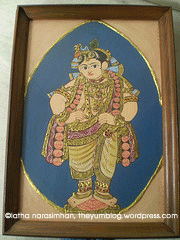Tiffin/Palaharam in Tamil Nadu was once usually served in the evening as snacks. That snack has been upgraded to breakfast fare, served with atleast one vegetable-lentil/coconut based side dish, thogayal/ chutney and curd. (If like my appa, you subsist on 95% vegetable diet, you will add a salad/soup). In the not so distant past, people ate what we eat for lunch as breakfast, a practice that is not uncommon even today. You know you are in Tamil Nadu if you see people waking up at 5am to eat a gigantic lunch at 9am.
No breakfast is repeated for atleast a month at Amma’s. Yes, she is that rare breed of modern day Tamilian not to have Idli/Dosa Maavu forever in the fridge, because she makes them just once in a month. And she doesn’t even go beyond the South Indian cuisine much as far as breakfast is concerned. This isn’t surprising considering the agriculture obsessed South Indian culture that not just worships the grains but prepares them using a wide range of techniques. At times the breakfast may just consist of steamed or roasted vegetables served with suitable sides. Variety needs inspiration, and it is a value to be incorporated from the earlier generation. Even on the standard Iyengar diet that excludes entire food groups including many vegetables, my Patti put together meals that were diverse with fresh experiences in flavour and texture. Cooking techniques, not just the spices, were used to render different flavours.
Thayir paniyaram is one such inspired recipe, created by altering the method of cooking for an existing dish (no prizes for guessing, but you may try).
tbsp=tablespoon, tsp=teaspoon, cup=standard metric cup measuring 250ml
Ingredients
- Par Boiled rice – 1 cup
- Urad dal – 1 tablespoon
- Grated coconut – 2 tbsp (heaped)
- Curry leaves – 1 twig
- Red chillies – 2
- Sour Curd (Yogurt) – 1 cup
- Salt – to taste
- Oil – 1 tbsp
Method
- Wash and drain the par boiled rice and urad dal. Add to the sour curd(yogurt) and soak overnight for 6-8 hours.
- Grind to a smooth batter adding grated coconut, red chillies and salt. Add curry leaves towards the end of grinding the batter. The batter must be thick but of pouring consistency (similar to cake batter).
- Heat the paniyaram pan, add a drop of oil to each of the moulds and pour the batter.
- Cover and cook over a medium flame. When the paniyarams start to puff up and separate from the pan, turn them over and cook the other side. Transfer to serving dish. Repeat for the rest of the batter.
I served it with Green Tomato Chutney and Poricha Kuzhambu.












 Read the Round up of all Entries Here
Read the Round up of all Entries Here